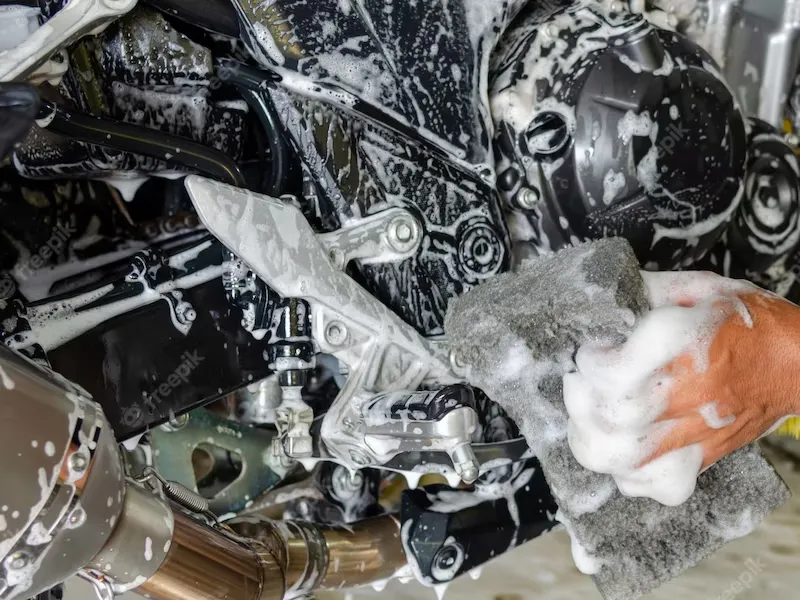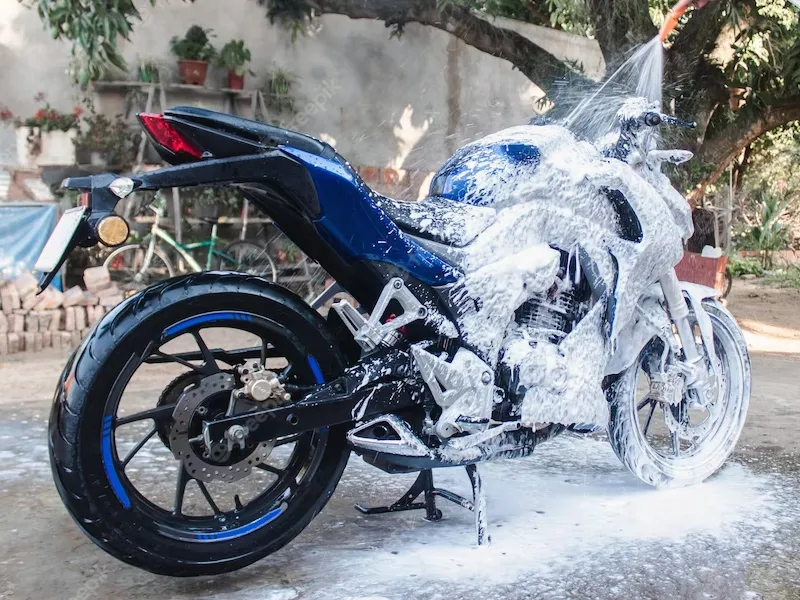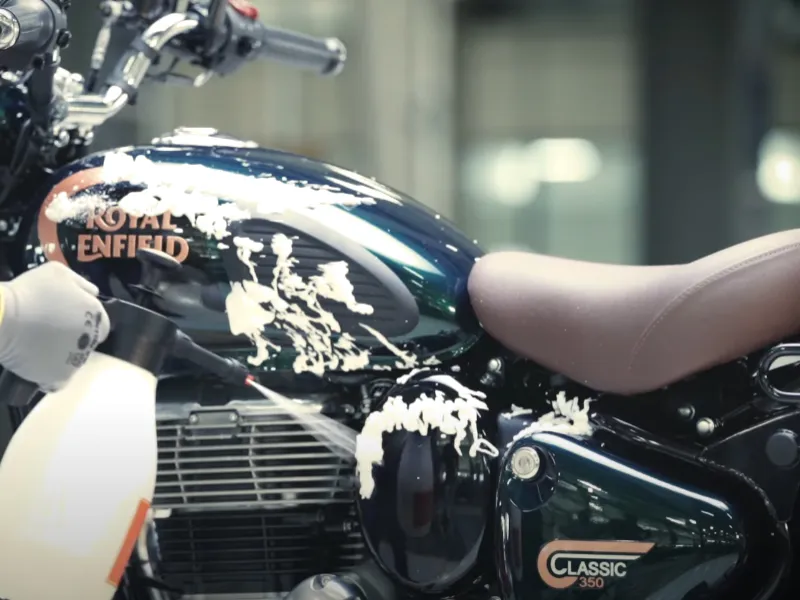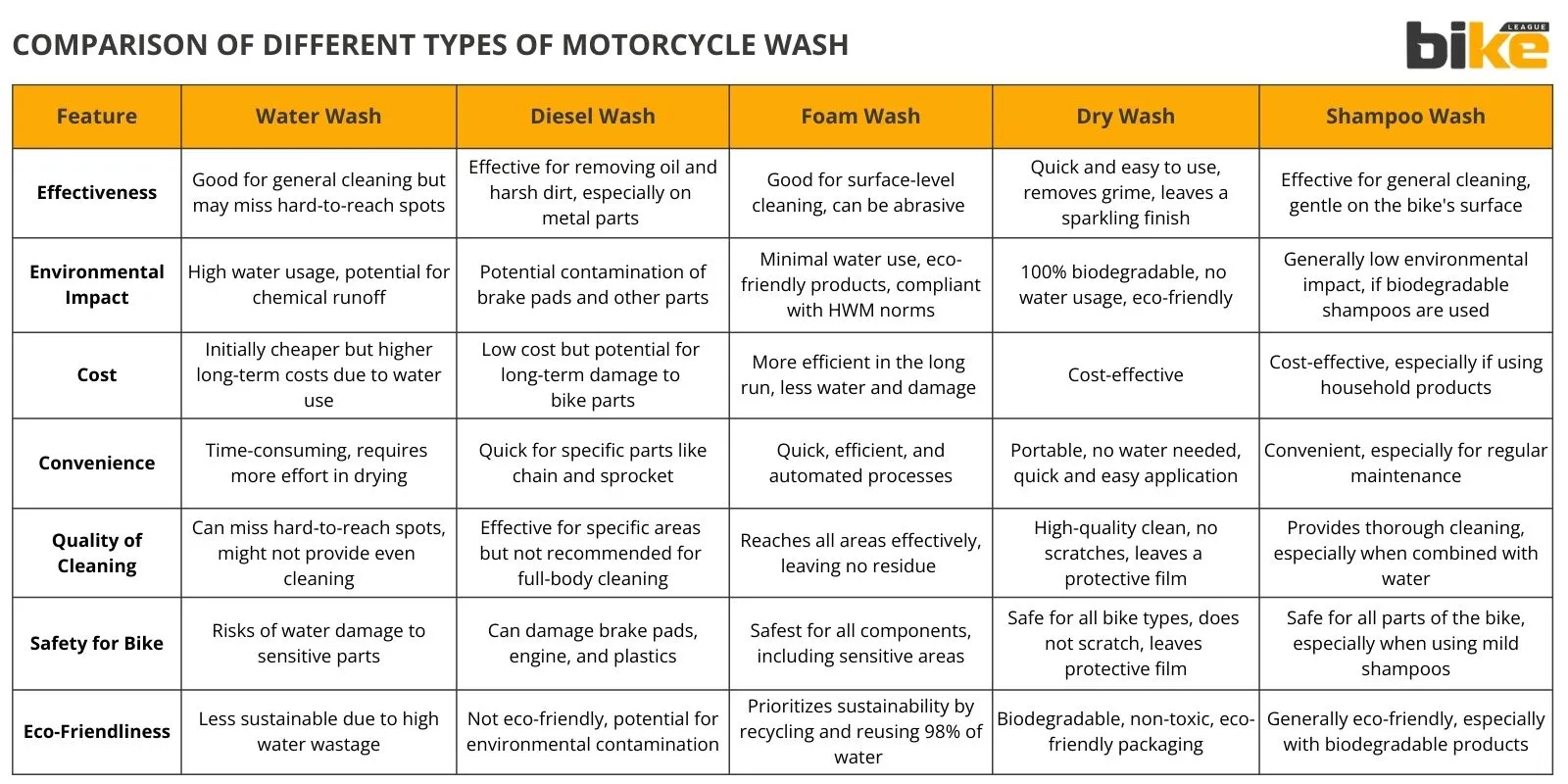
Long story short – Here we discuss the different types of bike wash in India, pros and cons, washing procedure, precautions, and FAQ in detail.
A bike or motorcycle wash is a necessary aspect of motorcycle maintenance and care. A motorcycle is a naked vehicle that can accumulate much dirt and debris compared to a car. Several methods and techniques exist for cleaning the bike, ranging from plain water to advanced chemical washes. All are equally good, but each has its pros and cons. The key consideration is the amount of time, facilities, and types of equipment available. So, we must consider all these factors before selecting a bike wash type to clean a bike.
With increasing pollution and tough environmental conditions, taking care of your bike requires more effort and time. Knowing the different types of motorcycle washes helps you clean your bike more effectively. Even though manufacturers use durable materials, regular care is still important. This guide will help you choose the right washing method for your motorcycle by explaining the pros and cons of each option.
Key Takeways
- Water wash uses high-pressure water jets to clean the bike, often combined with eco-friendly cleaning products.
- Diesel wash is very similar to water washing; the only difference is that diesel is used instead of water.
- Foam washing involves applying a thick layer of foam to the bike, which helps loosen dirt and grime before it is rinsed off, in much less time than shampoo washing.
- The major USP of shampoo wash is that it makes the water pH-neutral. Neither acidic nor alkaline water is suitable for bikes.
- The Dry wash method is for motorcycle owners in areas with high water scarcity or drought. Three accessories are required: a dry wash spray gun, a dry wash solution spray can, and a microfiber cloth.
Different types of bike wash or motorcycle wash to clean a bike
1. Water wash
It is the most basic type of bike wash. Water wash uses high-pressure water jets to clean the bike, often combined with eco-friendly cleaning products. The only other equipment needed is a dry and wet microfiber cloth. The wet one is soaked in water to clean the dirt, while the dry one wipes water marks after drying.
Pros of water wash
- Eco-Friendly: Utilises minimal water and eco-friendly products, making it a sustainable option for cleaning a bike.
- Efficient Cleaning: Guarantees thorough cleaning without the risk of water entering sensitive parts of the bike.
- Long-Term Efficiency: More efficient in the long run with less water and damage.
Cons of water wash
- Initial Setup Cost: Requires investment in high-pressure water systems and eco-friendly products, which can be costly initially.
- Water Usage: May require significant water usage, depending on the rinsing process.
- Water quality: Water can be acidic or alkaline, which is bad for the bike.
2. Diesel / Kerosene wash
Another method of washing a motorcycle at home is diesel washing. It is very similar to water washing; the only difference is that diesel is used instead of water. Diesel wash is best suited for oil and grease stains, and it also helps prevent rust formation to some extent, compared to other bike wash types. Compared to a water wash, less is required to clean a bike. However, the main disadvantage is that it can reduce and damage paint quality on metal and plastic surfaces. A diesel wash can be considered for parts underneath the motorcycle.
Pros of diesel wash
- It can remove some hard stains.
- Best for washing underneath the bike.
- Prevents rust formation to some extent.
- Removes oil and grease stains effectively.
Cons of diesel wash
- It can damage paint permanently.
- Expensive compared to water washing.
3. Shampoo wash
One of the best methods for washing a motorcycle. There are a lot of dedicated automotive shampoos out there in the market to do the same. The major USP of shampoo wash is that it makes the water pH-neutral. Neither acidic nor alkaline water is suitable for bikes. Accessories needed for shampoo washing are water, two buckets, two microfiber cloths, and shampoo. One thing to note here is to avoid confusing bike shampoo with the regular shampoo we use for our hair. Both are meant for different purposes, and detergents or household cleaning liquids should never be used. Shampoo wash can be done at home and by professional teams.
In-home, we can implement the two-bucket washing method for the shampoo wash to clean a bike, and the steps to do the same are
- Take water in two buckets, with one having slightly more water.
- Add bike shampoo to the bucket containing less water per quantity.
- Dip the microfiber cloth in shampoo water and start cleaning the bike from top to bottom, as bikes have more dirt in the lower area.
- Next, wash the dirty microfiber cloth in another bucket and remove as much dirt as possible.
- Now repeat steps 3 and 4 for the entire bike. One thing to keep in mind is never washing dirty microfiber in shampoo water. The purpose here is to keep shampoo water as clean as possible.
- After cleaning the entire motorcycle from top to bottom, let the motorcycle dry for some time and then use a dry microfiber cloth to remove mild stains.
- Do not perform a wash when the motorcycle is hot or under direct sunlight.
Pros of shampoo wash
- Effective Cleaning: Excellent at removing dirt without harsh scrubbing, protecting the bike’s finish.
- Gentle Cleaning: Shampoo wash is gentle on the motorcycle’s surface, preventing damage to the paint and finish.
- It can remove hard stains.
- Makes water pH neutral.
- Removes grease and oil stains.
Cons of shampoo wash
- Water Usage: Similar to water wash, it may require a significant amount of water for rinsing.
- Time-consuming method
- Need more accessories.
- Residue: If not rinsed properly, shampoo residue may remain on the motorcycle’s surface.
4. Foam wash
Foam washing is considered one of the most effective ways to clean a motorcycle. It works by covering the bike with a thick layer of foam, which loosens dirt and grime and rinses off faster than shampoo washing. The equipment for foam washing can be expensive, so many people prefer to have it done by professionals. If you want to do it at home, you’ll need to buy the necessary tools and make sure you have enough space.
A pressure washer and foam sprayer cannon are required for foam wash. These are the primary tools and are pretty expensive. Now, let’s discuss the steps or process for washing your bike with foam.
- Keep the bike on a centre or paddock stand first.
- Then, using water and a pressure washer, wash the motorcycle at an adequate distance between the pressure washer and the motorcycle so that parts are not damaged.
- Now fill the foam sprayer cannon with the mentioned shampoo and, using a pressure washer, apply it all over the bike at a safe distance.
- Wait 5-10 minutes to settle the foam over the motorcycle, then wash with water using a pressure washer.
- Now allow the motorcycle to dry. After 1-2 minutes, use a microfiber cloth or blower to clean and remove water or watermarks.
- One thing to care about is not washing from a single angle for a long time, as water can get into critical components.
- Do not perform a wash when the motorcycle is hot or under direct sunlight.
Pros of foam wash
- Effective Cleaning: Excellent at removing dirt without harsh scrubbing, protecting the bike’s finish.
- Thorough Coverage: The foam reaches all areas effectively, leaving no residue.
- Gentle on Surface: Can be gentle on the bike’s surface when using the right products.
- Less time: Short work duration compared to other washing methods.
Cons of foam wash
- Environmental Impact: Often uses harsh chemicals that can contaminate groundwater if not disposed of properly.
- Safety Concerns: The use of chemicals can create an unsafe work environment, posing health risks to manual bike washers.
- Water Wastage: Manual application often leads to water wastage.
- Expensive: Requires several tools and equipments
- Large work area: Requires enough work area or space
5. Dry wash
This method is for motorcycle owners in areas with high water scarcity or drought. Three accessories are required: a dry wash spray gun, a dry wash solution spray can, and a microfiber cloth. This method is very similar to a foam wash.
Now, let’s discuss the steps or process for performing a dry wash on your bike.
- First, we need to prepare the solution. As the official instructions state, mix the dry wash solution spray with minimal water.
- Pour the new solution into the dry wash spray gun and keep the maintained pressure in the spray gun per the official instructions.
- Keep a 2-3 feet distance between the spray gun and the motorcycle and apply the foam evenly across all surfaces.
- Now clean the surface with a microfiber cloth, and do not use a regular cloth.
- An important note is that you should not allow the foam to dry; clean immediately after application.
- Do not perform a wash when the motorcycle is hot or under direct sunlight.
Pros of dry wash
- Water Conservation: Completely eliminates the need for water, making it an eco-friendly option.
- Convenience: Can be done anywhere without the need for a water supply.
Cons of dry wash
- Surface Scratching: Improper use of dry wash products and cloths can lead to surface scratching.
- More time: The time taken to remove heavy dirt and tough stains is high.
- Limited Cleaning: May not be as effective in removing tough dirt and grime compared to wet wash methods.
As we discussed various types of bike washing, let’s address some common doubts and queries related to motorcycle washing.
Common Washing procedure & precautions for motorcycles
- Remove the ignition key and seal the ignition key barrel slot using adhesive tape.
- Please remove the tool kit and other relevant documents inside the side panels before proceeding with the motorcycle.
- Cover the silencer tailpipe, horn, and control switches with suitable plastic bags and tie them firmly to prevent water entry.
- Wash the motorcycle only when the engine is cold.
- Do not remove side panels while washing to avoid water entry.
- Brush the engine area with a recommended non-corrosive solvent to remove dirt or grease.
- Use a low-pressure water jet to clean.
- Do not use high-pressure washers or steam jet cleaners near the seal of the headstock bearing or steering stem
bearing, the seal of the wheel bearing, brake callipers, air intakes & exhaust outlets. - Do not apply corrosive solvent to painted surfaces or rubber parts.
- Use lukewarm water and mild detergent on the painted components to remove dirt, etc.
- Clean the motorcycle thoroughly with plain water to remove the detergent.
- Never directly spray water towards the instrument cluster’s bottom side to avoid water entry through breather holes.
- If possible, use compressed air and blow off water particles from the obscure areas of the motorcycle, electrical connections, etc.
- Once the motorcycle has been ridden in salty conditions (i.e., during winter in places where road salt is used) or near coastal areas, it is recommended to wash it with cold water after the ride to prevent corrosion or rust build-up. Please do not use warm water for washing, as it may damage the motorcycle due to a chemical reaction with the salt. After the washing process, once the motorcycle is completely dry, it is recommended to apply anti-corrosion spray on all the metal and chrome-plated areas to protect the parts from corrosion.
- It is recommended not to apply the anti-corrosion spray on the brake discs.
- Do not use petrol, brake oil or other flammable liquids to clean or wash electronic parts.
- The parts chosen using the motorcycle configurator should not be washed with soap or chemicals; use only plain water.
- Never spray water with great force on headlamp, speedometer, tripper, flasher lights, front and rear
wheel hubs, electrical connections and wires, control cables, spark plug, battery, ABS ECU, EMS ECU, side mirrors, steering stem, etc.
After Washing procedure for motorcycles
- Ensure the motorcycle is thoroughly dry by wiping it with a clean, soft, lint-free absorbent cloth or chamois leather.
- Remove all adhesive tapes.
- Lubricate control cables, pivots for footrest, side stand, centre stand, brake and gear shifter linkages, drive chain, etc., with lube oil.
- Polish the painted and plated surfaces using recommended automobile polishing wax.
- Start the engine and allow it to run at an idling speed for a few minutes to warm it up.
- Drive the motorcycle slowly, and apply both brakes intermittently to dry up the water in the brake pads.
- Please clean/wipe out water spills inside the RH side panel before keeping the tools kit and other relevant documents inside the left panel.
What specific eco-friendly cleaning products are recommended for a water wash on a motorcycle in India?
Recommended eco-friendly cleaning products for a water wash on motorcycles in India include:
- Weldtite Bike Cleaner Concentrate: A biodegradable cleaner specifically designed for bikes, safe for frames and components, effective in removing grime without harsh chemicals. Product link: Weldtite Bike Cleaner
- SASO Organic Car & Bike Shampoo: Made with 100% plant-based, chemical-free ingredients, this shampoo is pH-balanced for gentle and eco-friendly cleaning suitable for motorcycles.Product link: SASO Organic Car & Bike Shampoo
- Muc-Off Biodegradable Bike Cleaner: Utilises nano-technology to clean effectively while being free from acids and solvents, making it an eco-safe option.Product link: Muc-Off Biodegradable Bike Cleaner
- Grenove Eco-Friendly Cleaning Products: Indian brand offering green cleaning supplies that are biodegradable and safe for vehicle use.Product link: Grenove Eco-Friendly Cleaning Products
These products emphasise biodegradability, non-toxicity, and plant-based formulations, aligning well with eco-conscious motorcycle maintenance practices in India.
How often should each type of bike wash be performed for optimal maintenance in India?
For optimal motorcycle maintenance in India, the recommended wash frequency for different types of bike wash is as follows:
- Regular Water Wash: For daily riders or those using the bike frequently, a water wash once a week is ideal to keep the bike clean and prevent dirt build-up. For occasional riders, washing twice a month suffices.
- Chain Cleaning: Essential for safety and performance, chain cleaning should be done every 300 to 500 km or about once every 1-2 weeks, depending on usage and riding conditions. This removes grime and lubricates the chain to prolong life.
- Foam Wash: Foam washes, often using eco-friendly shampoos or cleansers, can be performed once every 1-2 weeks as part of deeper cleaning routines, especially after rides in dusty or rainy conditions.
- Post-Rain or Muddy Ride Wash: Immediate wash is advisable after heavy rains or off-road muddy rides to prevent rust and dirt-related damage.
These intervals strike a balance between cleanliness and the preservation of the bike’s components in the Indian climates and riding environments.
Are there any specific techniques for applying the foam wash effectively for a motorcycle?
Specific techniques for effective foam wash application on motorcycles include:
- Pre-rinse the bike with water to remove loose dirt.
- Use lukewarm water to mix with foam wash or shampoo for better cleaning efficiency.
- Apply foam evenly over the whole motorcycle using a foam cannon or foam sprayer, holding the bottle upside down so foam comes out.
- Let the foam sit for 5 minutes to lift dirt and grime without drying in the sun.
- Use a soft sponge or brush to scrub gently, especially on engine parts and crevices.
- Rinse thoroughly with medium-pressure water, avoiding high pressure on sensitive parts.
- Dry the bike with a microfiber cloth to prevent water spots.
FAQ related to different types of bike wash
1. Can we use ordinary clothes for a bike wash?
No. Always use a microfiber cloth for washing, as it prevents scratches and removes dirt effectively.
2. Can we use regular soap and detergent for washing a motorcycle?
No. Both contain chemicals that are harmful to paint and reduce its quality. Always use automotive shampoo for the same.
3. Can we use a pressure washer for the bike?
Yes. One thing to note is maintaining a 2-3-foot distance between the pressure washer and the motorcycle.
4. Is water pH a vital factor for bike wash?
Yes. Neither acidic nor alkaline water is good for bike washing. Either use filtered water or a pH-neutral automotive shampoo that helps maintain a neutral pH.
5. When to have a professional wash for your bike?
If you have limited time and accessories, opt for a professional wash. Additionally, consider a professional wash if you have limited space or no garage.
6. Is it okay to wash the bike with diesel?
No. Washing bikes with diesel can result in a loss of paint quality and gloss. But it can be cleaned underneath the motorcycle to remove hard stains.
7. How much distance should there be between the pressure washer and the motorcycle?
To prevent damage to paint and parts, keep a distance of around 2-3 feet.
8. What is the best type of bike wash for areas with water scarcity or drought?
Dry washing is the method used to clean a bike when there is a water scarcity issue.
9. Which is the best type of bike wash at home?
A water or shampoo wash is best if you clean the bike at home, as the required equipment is minimal, and the work area is sufficient.
10. Which bike wash removes hard stains and dirt best?
Foam and shampoo wash is the best one for hard stains and dirt.
11. Can we perform a bike wash in an open area?
Yes, but it must be under a sunshade. Washing under direct sunlight damages paint and exterior materials.
12. Should the bike be in the centre stand while washing?
Yes, it is for safety purposes. If the centre stand is unavailable, use a paddock stand instead.
Other related articles from Bikeleague India
- Diesel Wash For Bike: Is It Good or Bad
- Diesel bikes in India: Why are they absent on Indian roads ?
- Motorcycle service – All things you need to know explained
- Different types of motorcycles explained
- Different types of bike clutch explained
Conclusion
We’ve covered the main types of bike washes in India, along with their pros and cons, how to wash your bike, and important precautions. If you have more questions, feel free to email us at bikeleague2017@gmail.com or leave a comment below. We’re always happy to help. You can also connect with us on our social media platforms.





